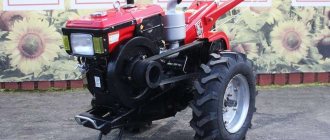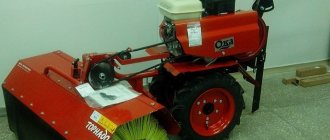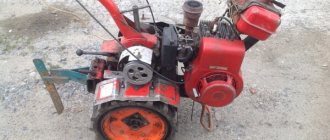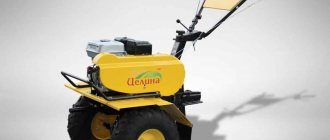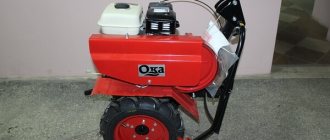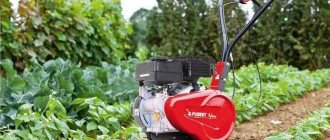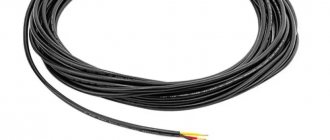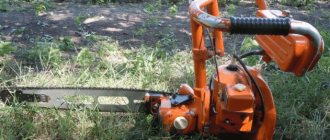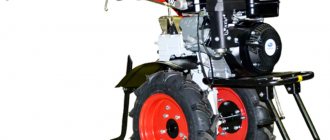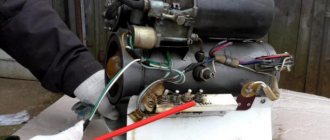Since the time cultivators and walk-behind tractors appeared on the market and became widely available, the daily life and work of a farmer has become significantly simpler. Even a household cultivator can significantly increase labor productivity and significantly reduce physical activity. And a professional walk-behind tractor is simply a mechanical “jack of all trades”! With its help, you can not only cultivate the soil, but also perform a whole range of land, gardening and household work.
Coping with large volumes of work with hand tools is too difficult and tiring. Buying specialized equipment for each type of work is too financially expensive. A rational solution is to buy a walk-behind tractor and the necessary additional equipment. The functionality of the machine will depend on the equipment that can be used.
Walk-behind tractor and walk-behind cultivator: the difference between the concepts
Often, unscrupulous sellers pass off motor cultivators as lightweight walk-behind tractors. Meanwhile, these two tools have enormous differences.
A motor cultivator is a mechanized unit designed to prepare the top layer of soil before sowing. It is used to remove weeds and mix fertilizers and nutrients with the soil.
A walk-behind tractor is more versatile. This is a mini-tractor capable of deep tillage.
Structurally they are also different. The traction force in a motor cultivator is created by a milling cutter mounted on the drive shaft. The walk-behind tractor uses the principle of wheel traction. The latter equipment weighs more and requires significant physical effort.
The features of the technology are demonstrated by photos of walk-behind tractors, which can be viewed at the end of the article in our gallery.
Spring work with a walk-behind tractor
Many people also use their tillers to prepare the soil for planting. This type of garden plow for a standard walk-behind tractor is usually a medium plow.
The single bottom plow is a corner moldboard, bent at an angle so that the soil being lifted rolls sideways.
- Double-bottom plows have a second plow positioned behind the first and to the left to dig a double-wide strip of land.
- A potato planting plow is a V-shaped gardening tool that digs a deeper, narrower hole instead of clearing a larger area of land like a bottom plow.
- The walk-behind plow, designed for soil preparation, is usually attached to a hook at the rear.
As the unit moves, it pulls the plow behind it and the blades cut into the ground. If the tractor is not a walk-behind tractor, it will likely not be able to move easily with such equipment.
There are other types of plows available, but most require a standard small or regular size option rather than a heavy mini tractor model.
Walk-behind tractor functions
The main area of application of the walk-behind tractor remains land work, including:
Plowing. It is done by hanging a plow on the device. The depth of the shoveled layer is determined by the engine power. Serious units can even cope with virgin soil. Well-tilled soil is rich in oxygen, which is essential for plant growth.
Harrowing. This is done with a special toothed nozzle. The process destroys the hard earth crust formed as a result of the drying of the upper soil layer. The circulation of air masses improves.
Hilling. You can't do without a hiller in a potato field. And here a walk-behind tractor comes in handy, using a special attachment to lift the soil, creating neat furrows.
Planting garden crops. For this purpose, additional components have been developed - seeders and potato planters. The volume of the tank into which the planting material is placed is comparable to three buckets of potatoes.
But the functionality is not limited to this. You can expand it by installing additional attachments for the walk-behind tractor: an aeration mechanism, a chopper or a motor pump.
In winter, the device turns into a compact snow blower. To do this, it is enough to equip it with knives, brushes and snow blowers. To transmit torque from the walk-behind tractor drive to the mounted mechanisms, a power take-off shaft is used.
What attachments can a walk-behind tractor have?
Walk-behind tractors usually go on sale with a limited set of equipment so that the base cost of the model does not increase. But there are many accessories that can be purchased additionally. • Trailer for walk-behind tractor. There are two types: cargo (trolley) and trailer-adapter. Depending on the power, the trolley can transport up to 500 kg of cargo. An adapter trailer consists of a seat and a frame onto which additional equipment can be attached to the rear. For example, a harrow. The seat allows the operator to operate the equipment comfortably and with limited physical capabilities. In this case, you can also use a walk-behind tractor as a full-fledged vehicle. Of course, the trailer is not intended for long trips (and the engine life will be greatly reduced), but it can transport various loads (fertilizers, crops) within your own farm.
walk-behind tractor with cargo trailer
• Cultivator cutter. One of the most popular attachments.
She plows the ground and breaks up large lumps. You can attach a different number of cutters, thus adjusting the width of tillage. Unlike a cultivator, the tillers of a walk-behind tractor do not bury themselves completely in the ground. Wheels prevent this. The cultivator cutter is sometimes installed immediately, and sometimes comes as an accessory
• Plow for walk-behind tractor .
Like the cultivator, it is used for plowing the land. However, this leaves large layers, like after a tractor. It is advisable to use a plow in cases where you need to quickly plow previously uncultivated land and separate one dacha plot from another by plowing. A plow for a walk-behind tractor allows you to plow up virgin soil
• Harrow. With this tool you can break up large clods of earth after the plow, remove stones, and rake up weeds. • Hiller. The name of this device speaks for itself.
Manufacturers produce hillers in two versions: disk and V-shaped ploughshare. Disc hillers cling in front of the walk-behind tractor or on the sides. They rotate and do not create additional resistance during operation. The ploughshare naturally clings to the rear and makes it possible to perform several operations simultaneously due to the equipment mounted at the front. Hillers are mainly used for potato cultivation
• Spade blade. In fact, it is a smaller version of a bulldozer knife. With its help you can remove a bunch of sand, rubble, earth, and rake snow. • Rotary auger snow blower. It is used for high-quality snow removal when there is a lot of snow and you cannot achieve the desired effect with a shovel-mouldboard. In addition, this equipment easily breaks compacted snow and ice crust and throws them at a distance of up to 20 meters. Of course, such a snow blower for a walk-behind tractor should only be purchased in those areas where the amount of precipitation is appropriate. • Potato digger . The purpose of this tool is to harvest potatoes without damaging the roots. They may differ in their design (vibration, conveyor), but the essence remains the same: it clings to the walk-behind tractor from behind, while working, one edge goes into the ground to a depth slightly greater than planting potatoes and lifts root crops to the surface. Thanks to vibration, they are cleared of the earth. All that remains is to walk and pick up the potatoes. • Potato planter. The device significantly speeds up the process of planting potatoes. It consists of a container for planting material and a mechanism that performs three functions simultaneously: it digs a hole, immerses the potato in it and buries it. • Mower. There are rotary and knife types.
The blade one is less powerful, but it can be used to mow grass between trees and bushes. A walk-behind lawn mower allows you not so much to bring beauty to large lawns as to make hay. • Branch chopper. A very useful tool that reduces waste in gardening. After all, after pruning trees or after completely removing them, many small branches remain. They are not suitable for firewood and are often burned in a fire. However, thanks to the shredder, you can get wood chips, which can then be used as mulch or thrown into the compost. • Rotary brush . With such a device installed on a walk-behind tractor, you can sweep large areas, clean asphalt or tiles from dirt and ice. In addition, this will allow people with disabilities to perform such work.
Types of walk-behind tractors
There are 3 classes of machines based on engine type:
Gasoline walk-behind tractors. Their advantages include high power, ease of control and productivity. They create less noise than diesel counterparts. Another reason for their popularity is environmental friendliness (the volume of gases released during operation is much less than that of other types).
How to choose a piston compressorIn what cases is washing machine repair needed, what should everyone know?
Do-it-yourself wood splitter - drawings, diagrams, dimensions. 120 photos of homemade wood splitters
Diesel walk-behind tractors. Despite the low cost of fuel, the unit itself will cost more than its gasoline “brother.” They are characterized by high cross-country ability, which allows them to be used over large areas.
Motoblocks with electric motors. These are lightweight models that are convenient for processing limited areas, for example, the ground in greenhouses.
Mowing grass with a walk-behind tractor
A walk-behind tractor can help when making hay. To do this, it is not necessary to take out an ancient tool from the barn and go to the hayfield; it is enough to use the appropriate attachments. Most often, the mower is a basic attachment included in the kit . The mowing process itself should not cause any complaints; it is enough to carefully study the instructions and properly prepare the device for use.
The main problems when working with a mower are dull blades and belt drive spinning. It will be enough to remove the knives, clean and sharpen them. The belt must be inspected visually and, if the weakening is noticeable to the eye, simply tighten it slightly to normal using the “original” hexagon. Since the walk-behind tractor operates at high speeds during operation, some bolts may become loose. This may cause hum and vibration. To solve this problem, it will be enough to simply pull all the fasteners “in a circle”.
The user decides whether it is better to mow with a walk-behind tractor or a lawn mower. A gasoline trimmer is more mobile, but makes a lot of noise, and also requires constant topping up of fuel and monitoring fuel and lubricants. An electric trimmer is ineffective in a field where there is nowhere to plug in an outlet, which is where haymaking is most often done. A walk-behind tractor may be completely useless in confined spaces.
Recommended Manufacturers
Today, walk-behind tractors are produced by both domestic and foreign companies. In practice, the former are more affordable and less demanding on fuel quality. But poor-quality assembly and manufacturing of component parts are a common cause of breakdowns and failures.
Manufacturers of walk-behind tractors occupying leading positions in the market: Salyut or Neva (both Russia), Caiman (France), Greenfield (China), Belarus (Belarus), Hyundai (Korea).
Let's briefly look at the best models in the rating of walk-behind tractors:
“Belarus 09N-01” - refers to heavy walk-behind tractors, with a strip width of 70 cm and a digging depth of 20 cm. Four-stroke gasoline engine 9.4 hp. allows you to lift even virgin soil.
Advantages: functionality, the ability to use large attachments. Cons: problems with the clutch and gear shifting. Starting price - from 80,000 rubles.
"Hyundai T 2000E" is a lightweight unit capable of processing an area of up to 25 acres. Model parameters: strip width 55 cm, depth - 25 cm. A distinctive feature is a 2.7 hp electric motor. Approximate price - 20,000 rubles.
"Neva MB-23SD-27F" - characterized by a power of 5.5 l/s, three gears (including reverse). Cultivates the soil to a depth of up to 20 cm, with a grip of 85 cm. Pros: low cost and availability of repairs, developed network of service centers. Average price - 90,000 rubles.
“CAIMAN 330” is a walk-behind tractor equipped with a Japanese Subaru engine (power 9 hp). There are 5 speeds to choose from, 2 of which provide reverse. The processing width reaches 60 cm, depth - 20 cm. Positive aspects - long service life, high-quality assembly. Among the few disadvantages is the high price, starting from 190,000 rubles.
Whatever model of walk-behind tractor you choose, pay close attention to the warranty and the availability of service centers for this equipment in your city.
Leveling the area using a walk-behind tractor and cultivator
This type of equipment is suitable not only for agricultural needs. A cultivator or walk-behind tractor can be used for landscaping work. You can level your dacha plot with improvised means, a shovel and a rake, as well as with the help of utility equipment, but if the area is hilly or replete with stumps and a developed root system, heavier equipment may be required.
Leveling the area with a cultivator is only possible if there are minor unevennesses that can be eliminated without resorting to additional technical means (a tractor with a bucket, etc.). The walk-behind tractor is capable of diving a little deeper, but on average, the diving area reaches 15-17 cm. Further leveling of the area occurs with the help of a rake. The loosened soil should be evenly distributed throughout the area.
If the soil on the site is too hard, rocky, or if there are stumps that have not been uprooted, etc., it would be better to resort to the services of a tractor. It would be better to dig up solid objects, such as a large stone buried a considerable distance into the soil, or an overgrown rosehip bush deeply rooted in the area, using a regular bayonet shovel. Only after removing parts that interfere with loosening and removing large debris can you begin to work using a walk-behind tractor.
It is important to remember that operating a walk-behind tractor and cultivator on hilly terrain and other uneven terrain is associated with an increased risk.
For what purposes is a walk-behind tractor needed?
Many people today have at their disposal a summer house, a vegetable garden or a garden.
And as soon as spring comes, summer residents rush to their haciendas, not to relax, but rather to work, and work physically hard. It is for this reason that in the work of a summer resident and farmer it is extremely important to mechanize river work. You can loosen the soil, dig up the area, water it, fill a container with water, etc. And this is where a walk-behind tractor will help you a lot.
It should be noted that recently in European countries there has been a widespread interest in devices that can significantly simplify the entire procedure of gardening. And one of these tools is a walk-behind tractor.
A walk-behind tractor is something between a tractor and a shovel. That is, it all depends on what additional equipment will be installed on the walk-behind tractor. The more devices attached to it, the more different functions it can perform. However, before buying a walk-behind tractor, you should decide for what functions you need it. This is quite important because it will determine which model you need.
There are also motorized cultivators that are assistants in the garden. And for the simplest purposes such a motor cultivator is quite enough. The differences between a walk-behind tractor and a walk-behind cultivator are that the latter is created only to loosen the soil, while a walk-behind tractor can use additional equipment for work. As you understand, its functions increase at the same time.
And if you have decided on your goals, then you can safely buy yourself a motor cultivator. This is a universal unit that will be useful to you in any situation. And if you are a summer resident, you simply must have it.
Walk-behind tractor class
When buying a walk-behind tractor, first of all, you should decide on the category (class) - a professional or amateur walk-behind tractor has different functionality and cost. For a summer cottage plot of 4-7 acres in size, a professional walk-behind tractor is unlikely to be required.
It is quite possible to limit yourself to an amateur model; there are quite a lot of such walk-behind tractors on the market now. For a garden of 20 acres or more, you may need a semi-professional walk-behind tractor, which has an expanded range of functions compared to an amateur one. If you are considering a vegetable garden with an eye toward the market and making a profit, then your choice will most likely be a professional walk-behind tractor.
In addition to the most expanded set of functions, a professional walk-behind tractor makes it quite easy to use it with other devices (water pump, mower head, circular saw, electric generator, etc.).
How to choose a walk-behind tractor for the garden
To decide how to choose a walk-behind tractor for your garden, you should calculate the size of the land plot. The optimal performance of a self-propelled unit can be determined by the following parameters:
- Up to 15 acres: 3.5-4 horsepower, working width 60 cm;
- Up to 30 acres: 4.5-5 horsepower, grip 80 cm;
- Up to 0.5 hectares: 6-7 horsepower, grip 90 cm;
- Up to 4 hectares: 10 horsepower, 100 cm reach.
If the beds are located on an area exceeding 4 hectares, it is better to use more powerful equipment for the garden, for example, a tractor.
Operational differences between gasoline and diesel walk-behind tractors
To decide which walk-behind tractor will do the job better, it is enough to identify the main operational differences:
- A gasoline walk-behind tractor is endowed with relatively high power, so it can process large areas. It has a low noise level, is environmentally friendly, easy to operate, and weighs less than a diesel unit.
- A diesel walk-behind tractor is economical because its fuel costs less than gasoline. However, this type of equipment has a disadvantage - sensitivity to weather conditions. At sub-zero temperatures, starting the unit will not be easy.
A small-sized gasoline tractor makes less noise, has a low vibration level, and is easy to start. Diesel vehicles consume little fuel, are easy to operate and maintain, and have high traction force.
